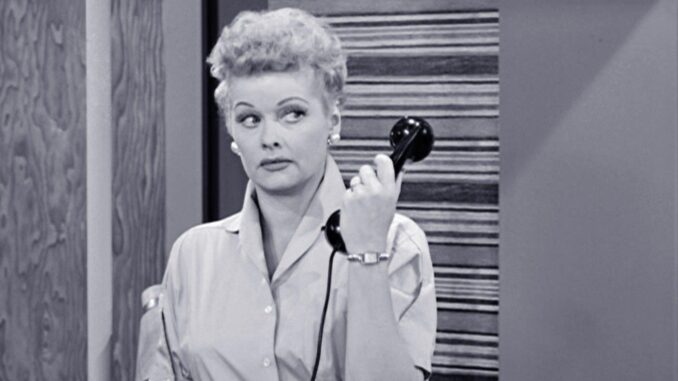
I Love Lucy: The Complete Series
In October 1951, Lucille Ball and Desi Arnaz debuted the first episode of what was to become one of the best-loved and most watched TV shows of all time. Zany redhead Lucy and her Cuban bandleader husband Ricky Ricardo, along with their neighbors and comic foils Ethel and Fred Mertz (Vivian Vance and William Frawley), got into the most hilarious predicaments ever imaginable. Overflowing with notable guest stars and escapades that never lose their entertainment value, it’s no wonder why everyone still loves Lucy. This must-own collection contains all the classic episodes from the six seasons of “I Love Lucy” (1951-1957) plus the iconic remastered “The Lucy-Desi Comedy Hour “(1957-1960), and a newly colorized and never-before-released “Lucy and the Loving Cup” episode.
For more about I Love Lucy: The Complete Series and the I Love Lucy: The Complete Series Blu-ray release, see I Love Lucy: The Complete Series Blu-ray Review published by Martin Liebman on January 18, 2025 where this Blu-ray release scored 4.0 out of 5.
I Love Lucy: The Complete Series Blu-ray, Video Quality
CBS/Paramount brings I Love Lucy (as well as The Lucy-Desi Show) to Blu-ray with a collection of 1080p transfers that are not dissimilar from the quality found on the seasons one and two issues (click here for a season one review and here for a season two review). Throughout, the image does maintain the original 4×3 aspect ratio (placing vertical “black bars” on the 1.78:1 HD display) and is, of course, presented in black-and-white. The image ranges from solid to serviceable to suffering. First a few words on the black and white scale. Overall, viewers will find good contrast to the black and white elements, including healthy blacks and nicely balanced whites, the former never appearing crushed and the latter, while not dazzling, never pushing overtly creamy, either, though favoring a creamier appearance to crisp white to be sure.
Like seasons one and two before them, the remaining seasons struggle too really look the part of a shot on film classic that should be beautifully grainy and naturally sharp. Instead, the best the show can muster is “decent.” It shifts around quite a bit from looking borderline faithful for clarity and grain to frequently appearing fairly inorganic, with dense, snowy grain and good-not-great detailing. For the most part it looks good, but it never looks great. It flirts with great very intermittently, but for the most part it’s clear some serious work is needed. Season five, however, sees a dramatic dip in quality. It looks smoothed over, soft, far less sharp than the previous season, and even the snowy grain seems reduced to leave the image looks flat and bland. It’s a fairly frustrating experience, on the whole. If one is watching from, say, ten feet back on a 75″ screen it’s going to look OK, but cut that distance in half and the warts really start to stand out.
There is little bit of aliasing on clothing with challenging patterns (look at Ethel’s top in the season four episode “Ethel’s Birthday” around the 4-minute mark or so). Aliasing, some jagged edges here and there, and various examples of light speckles and pops are in evidence throughout the series run. This could stand to look a whole lot better, but it it doesn’t look band enough to do more than through up a caution flag.
Paramount brings I Love Lucy: The Complete Series to Blu-ray with two soundtracks (LPCM 2.0 tracks for the first two seasons and DTS-HD Master Audio 2.0 lossless soundtracks with the later seasons; please click here for a season one review and here for a season two review). The DTS-HD Master Audio 2.0 soundtracks which accompany the later seasons are straightforward and unremarkable. They are effective at the base level, conveying the show’s audio requirements with necessary clarity but not much more. Generally speaking, everything is just bunched up in the middle area: music, dialogue, crowd laughter, all the key sonic ingredients at play in any given episode. These are presented with adequate clarity. Certainly the opening title music sounds a little compact and muddy, but music can and does open up a little more to superior definition and fidelity in spots. Laughter is neither wonderfully defined nor poorly defined, and the center placement doesn’t really allow it to be set apart form everything else. Dialogue is clear and centers nicely in the absence of a dedicated center speaker.
